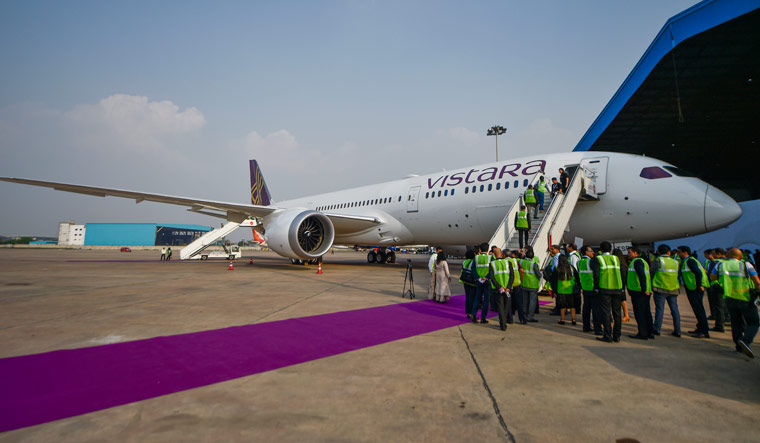There is an unwritten rule that has been floating around Air Vistara’s glitzy head office in Gurgaon for the last several months — thou shalt not speak about the impending merger with Air India, when Vistara will cease to exist as a brand.
So much so that Vistara CEO Vinod Kannan told THE WEEK, mighty seriously if I may add, that “we remain committed to redefining air travel (and) setting new standards.”
Even by that strictly enforced non-rule order, there couldn’t but be Chinese whispers this weekend, as news came trickling in that the Competition Commission of India (CCI) had approved Vistara’s merger with Air India. There was a sense of finality, putting to rest all ‘hope-against-hope’ scenarios that there could perhaps be an additional lease of life to an airline that in just eight years or so had proved itself as perhaps the finest India has seen.
While a full absorption of the Vistara team into Air India is the likely scenario, the logistics and nitty-gritty remains to be seen. Of course, Air India will have a lot to learn in operational efficiency and service quality from Vistara — the very fact that its new livery is inspired at least in part by Vistara’s aubergine and gold colour code. The fact that the airline’s operations will shift from central Delhi’s Airlines House to Gurgaon, promises that the legacy of Vistara may still have a role to play in the coming years of transformation of the once-state-run carrier.
“All our efforts since inception have been directed towards (making) Vistara the finest and truly world-class airline from India,” Kannan told THE WEEK. It does have the laurels to prove it, including a plethora of awards, becoming the only Indian airline to enter the list of the world’s top twenty best airlines. Surely, there are lots of leaves ‘sarkari-jaded’ Air India could take out of Vistara’s books if it wants to.
But what is clear is this: come April, there will be no more UK coded flights, with flight rationalisation, merging and optimisation of routes to be worked out by the operations team at Air India.
The CCI, India’s anti-trust body, had looked into the Vistara merger after a series of events led to the govt-run Air India finally being privatised and being returned to its original owners, the Tata’s. The Tatas had wanted to get back into aviation for decades since they were ejected out of Air India, and had formed a partnership with Singapore Airlines (SIA) in the early 2000s hoping that Air India would be divested and they could take it over soon. However, as politics kept delaying it, the Tatas in frustration decided to venture forth with a Greenfield venture of their own, launching Vistara in partnership with SIA in 2014 (service started in 2015).
While Vistara instantly became popular with travellers wanting a full-fledged travel experience (lounges, business class, full meal service, freshly brewed Starbucks coffee etc), it ran into a conundrum once Air India was finally sold off to the Tatas in 2022. Tatas soon decided in optimising the four airlines they suddenly had in their portfolio — low-cost operators Air India Express (the low-cost wing of Air India which operated flights to the Gulf region) will be merged with AirAsia India (which the Tatas had originally partnered with Malaysia’s AirAsia before buying them out) into one low-cost carrier--Air India Express; while full-fledged service operators Air India and Vistara will be merged into one, the flagship Air India.
CCIs investigation had focused on primarily two matters. One, on the fact that the merger of Air India and Vistara will lead to the monopoly of Air India in the full-fledged carrier space. The other pertained to the acquisition of shares of SIA, a foreign entity. While SIA held 49% in Vistara, they will now hold 25.1% in the merged final entity, Air India Limited.
The Vistara merger is expected to be completed by the end of this financial year, in March 2024.



